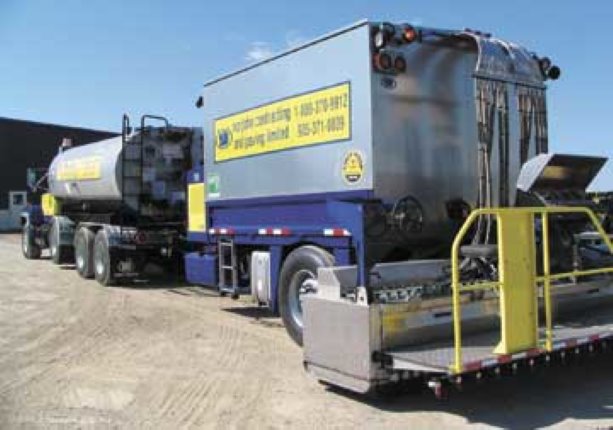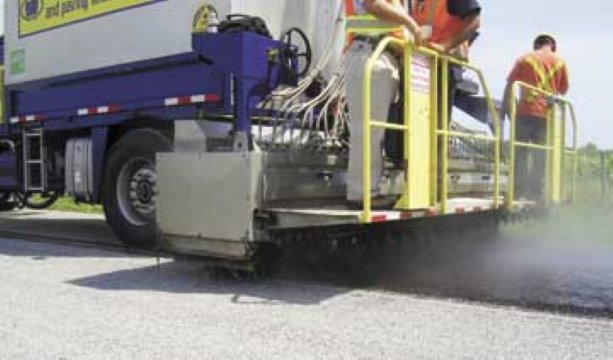FiberMat technology — the process of sandwiching chopped fibreglass filaments between two thin layers of polymer-modified asphalt emulsion — is emerging as a powerful weapon to mitigate road surface cracks in Ontario. The technology was developed by French company Colas and is represented in Canada by Alberta-based Canadian Road Builders Inc., a subsidiary of ColasCanada Inc. The technology is licensed in Ontario to Walker Industries subsidiary Norjohn Contracting and Paving Limited of Niagara Falls.
“I first saw the technology demonstrated at a trade show in 2006,” says Marty Koabel, division manager at Norjohn. “After investigating some actual applications in New York state and reviewing the application process on several municipal job sites I decided it was a no-brainer — something we would find easy to sell.”
Norjohn has held the licensing rights to apply the product in Ontario since 2007. The contractor first applied a test patch at sister company Walker Aggregates’ Vineland quarries in Vineland, inviting representatives from several municipalities to view the proceedings.
“If you take a small sample of the material between 1/4-inch and 3/8-inch thick, you simply can’t break it apart,” says Koabel. “The fibres substantially increase the tensile strength and provide greater resistance to reflective cracking, in part by absorbing some of the strain on the pavement caused by vehicle loads on the overlay. It also provides greater resistance to the freeze-thaw cycle, one of the major enemies of Ontario pavement.”
A traditionally sized crew of about nine workers, plus traffic control, is involved in the application. The product is applied using a purpose-built FiberMat machine housed inside a trailer, which is leased to the licensee. The machine consists of two application bars and a device that unrolls large rolls of fibreglass, then cuts and distributes the fibres under computer control.
“In operation, it looks like a high-tech giant Singer sewing machine,” says Koabel. “One of the bars applies a layer of asphalt emulsion up to four metres wide, while fibres five to eight centimetres long are blown across it. A second spray bar applies a final layer of emulsion on top, which locks the fibres into place. We then top it off with aggregate chips from a chip spreader, followed by two rollers.”
Used as a surface remediation treatment, the technology is referred to as a Stress Absorbing Membrane (SAM). When placed underneath the final asphalt layer, FiberMat uses a modified asphalt emulsion and is known as a Stress Absorbing Membrane Interlayer (SAMI).
The company’s first official contract was executed in St. Catharines in 2007 on an 8,200-square-metre section of road. Since then, the company has applied the product on more than 1.5-million square metres of pavement in projects ranging from Oxford, Norfolk, Bruce, Grey and Simcoe counties, to Niagara Falls, Niagara-on-the-Lake, Hamilton and Woodstock. One year after application in the earliest municipal projects, core samples of the SAMI applications showed no cracking.
The most extensive test application was conducted in 2009 on behalf of the Ontario Ministry of Transportation (MTO) on a 12.75-km section of Highway 62, near Madoc, north of Belleville. The 30-year-old surface had demonstrated significant reflective cracking. The successful project bidder, Coco Paving, subcontracted Norjohn to execute the FiberMat process.
“It all happens very quickly, using fast-setting emulsion,” says Koabel. “We do one lane at a time and if it’s used as a surface layer, the road can be open to traffic within 30 minutes of when we began that particular section. In this case, the entire FiberMat surface was applied in just three to four days, followed by traditional paving.”
In a report on the process, MTO notes: “Costs associated with SAMI applications are relatively competitive compared to other reflective cracking mitigation systems. Industry experience suggests that SAMI can extend the service life of pavements three-fold… ”
As a result of the test, which displayed significant mitigation of reflective cracking, MTO has offered contractors the option to bid on the treatment of asphalt cracking using either the fibreglass SAMI process or a similar process using a geotextile mat.
Koabel says that, while the product has been used only on pavement preservation projects in Ontario to date, it may have applications in new construction as well. “We’re investigating ways of taking road construction to a whole new level,” he says.




Recent Comments
comments for this post are closed